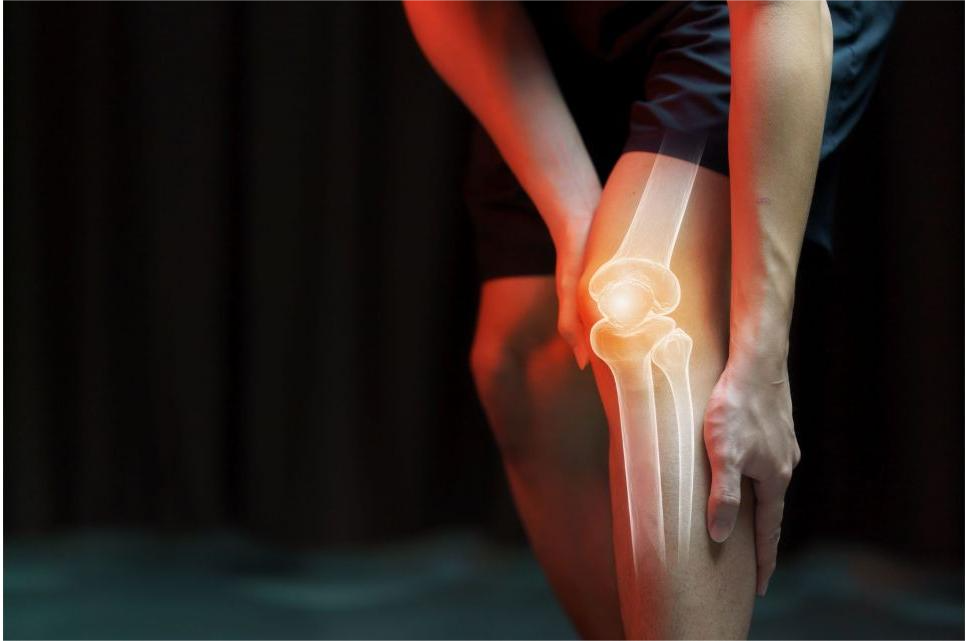创新背景
非处方止痛药、物理疗法、类固醇注射……有些人已经尝试了所有的方法,但仍在忍受膝盖疼痛。膝关节疼痛通常来自于软骨渐进式的磨损和撕裂,即骨关节炎,全球近六分之一的成年人受此影响。
创新过程
杜克大学领导的一个研究小组已经创造了第一个凝胶基软骨替代品,它比真正的软骨更坚固、更耐用。机械测试表明,杜克大学团队的水凝胶——一种由吸水聚合物制成的材料——可以比天然软骨承受更大的压力和拉力,抗磨损能力是天然软骨的三倍。
为了制造这种材料,杜克大学的研究小组将薄的纤维素纤维薄片注入一种名为聚乙烯醇的聚合物,以形成凝胶。聚乙烯醇是一种由重复分子链组成的粘性粘性物质。纤维素纤维的作用就像天然软骨中的胶原纤维一样,它们在拉伸时给予凝胶强度。聚乙烯醇可以帮助它恢复原来的形状。

天然软骨在达到断裂点之前,可以分别承受每英寸5800到8500磅的巨大拉力和挤压。实验室制造版本是第一个可以处理更多水凝胶的版本。它在张力上比天然软骨强26%,就像把七架三角钢琴从钥匙圈上悬挂起来一样,在压缩方面强66%——这就像把一辆车停在邮票上一样。
在过去,研究人员试图创造更强的水凝胶,使用冻融过程在凝胶中产生晶体,这将驱除水,帮助聚合物链保持在一起。在这项新的研究中,研究人员没有对水凝胶进行冷冻和解冻,而是使用了一种称为退火的热处理方法来诱导聚合物网络中形成更多的晶体。
通过增加晶体含量,研究人员能够生产出一种凝胶,与冻融法相比,它能承受5倍的拉力和近两倍的挤压压力。退火凝胶强度的提高也帮助解决了第二个设计挑战:将其固定在关节上,并使其固定。

基于水凝胶的植入物可以替代磨损的软骨并减轻膝盖疼痛,而无需更换整个关节。
软骨形成一层薄薄的覆盖在骨头的末端,这样骨头就不会互相摩擦。之前的研究无法将水凝胶直接附着在骨头或软骨上,以足够的强度防止它们松动或滑落。因此,杜克大学团队想出了一种不同的方法。
他们的附着方法包括用胶结剂将水凝胶夹紧在钛基上。然后将其压紧并固定在受损软骨原来所在的洞中。测试表明,这种设计比骨上的天然软骨牢固68%。
其他研究人员曾尝试用金属或聚乙烯制成的膝关节植入物替代受损的软骨,但由于这些材料比软骨更坚硬,它们可能会摩擦膝盖的其他部位。
在磨损测试中,研究人员将人造软骨和天然软骨相互旋转100万次,其压力类似于走路时膝盖所承受的压力。使用一种被称为微计算机断层扫描(micro-CT)的高分辨率x射线扫描技术,科学家们发现他们实验室制造的版本的表面比真实版本的好3倍。然而,由于水凝胶模仿了真正软骨的光滑、滑滑和软垫性质,它可以保护其他关节表面在与植入物滑动时免受摩擦。
创新关键点
杜克大学的研究小组将薄的纤维素纤维薄片注入一种名为聚乙烯醇的聚合物,以形成凝胶。聚乙烯醇是一种由重复分子链组成的粘性粘性物质。纤维素纤维的作用就像天然软骨中的胶原纤维一样,它们在拉伸时给予凝胶强度。聚乙烯醇可以帮助它恢复原来的形状。
创新价值
机械测试表明,杜克大学团队的水凝胶——一种由吸水聚合物制成的材料——可以比天然软骨承受更大的压力和拉力,抗磨损能力是天然软骨的三倍。
对于那些想要避免更换整个膝关节的人来说,可能很快就会有另一种选择,可以帮助患者快速,无痛地重新站起来,并保持这种状态。
A new 'cartilage replacement' could ease knee pain
A team led by Duke University has created the first gel-based replacement for cartilage that is stronger and more durable than real cartilage. Mechanical tests showed that the Duke team's hydrogel -- a material made of water-absorbent polymers -- could withstand greater stress and tension than natural cartilage and resist wear and tear three times better.
To make the material, the Duke team injected thin sheets of cellulose fibers into a polymer called polyvinyl alcohol to form a gel. Polyvinyl alcohol is a sticky sticky substance made up of repeating chains of molecules. The cellulose fibers act like collagen fibers in natural cartilage, they give gel strength when stretched. Pva will help it regain its original shape.
Natural cartilage can withstand tremendous tension and compression of 5,800 to 8,500 pounds per inch, respectively, before reaching the breaking point. The lab-built version is the first that can handle more hydrogels. It is 26 per cent stronger in tension than natural cartilage, which is like dangling seven grand pianos from a key ring, and 66 per cent stronger in compression - which is like parking a car on a postage stamp.
In the past, researchers have tried to create stronger hydrogels, using a freeze-thaw process to produce crystals in the gel, which would expel water and help the polymer chains hold together. In the new study, instead of freezing and thawing the hydrogels, the researchers used a heat treatment method called annealing to induce more crystals to form in the polymer network.
By increasing the crystal content, the researchers were able to produce a gel that withstood five times the pulling force and nearly twice the squeezing pressure compared to the freeze-thaw method. The increased strength of the annealed gel also helped solve the second design challenge: attaching it to the joint and making it immobilized.
Cartilage forms a thin layer that covers the ends of bones so they don't rub against each other. Previous studies were unable to attach hydrogels directly to bone or cartilage with enough strength to keep them from loosening or slipping off. So the Duke team came up with a different approach.
Their attachment method involves clamping the hydrogel to a titanium base with a binder. It is then pressed down and fixed in the hole where the damaged cartilage used to be. Tests showed that the design was 68 percent stronger than the natural cartilage on bone.
Other researchers have tried replacing damaged cartilage with knee implants made of metal or polyethylene, but because these materials are harder than cartilage, they can rub against other parts of the knee.
In the wear test, the researchers rotated the artificial and natural cartilage around each other a million times at a pressure similar to that experienced by the knee when walking. Using a high-resolution X-ray scanning technique known as micro-computed tomography (micro-CT), the scientists found that the surface of their lab-made version was three times better than the real version. However, because the hydrogel mimics the smooth, slippery, and cushioning properties of real cartilage, it can protect other joint surfaces from friction as they slide against the implant.
智能推荐
新材料 | 创新开发新系统“micro-CAL”可在玻璃结构中打印微尺度特征
2022-11-08加州大学伯克利分校的研究人员开发了一种3D打印玻璃微结构的新方法,该方法速度更快,可以生产出具有更高光学质量,设计灵活性和强度的物体。
涉及学科涉及领域研究方向新材料 | 创新利用”catholyte”开发新材料可使植入式电池更持久
2022-11-07研究人员提出了一种新方法来提高这些不可充电电池的能量密度,种技术可以使使用寿命增加50%。
涉及学科涉及领域研究方向创新使用木质涂料降低医院器具表面的微生物
2022-08-02将树脂和树皮与医院使用的抗菌材料进行对比,考虑木质涂料的可用性。
涉及学科涉及领域研究方向新材料 | 3D打印利用聚合技术产生“活的”4D材料
2022-09-214D打印是3D打印的一个子集,打印的对象可以根据特定的条件改变其形状。新南威尔士大学悉尼分校的研究人员将3D / 4D打印与化学工艺相结合,以生产“活”树脂。
涉及学科涉及领域研究方向